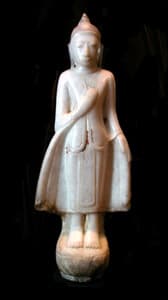Shan Marble Sculpture of Buddha Standing, 18th Century CE
Marble
22
X.0233
The Shan people are a distinct ethnic group that today constitute Myanmar’s largest minority group. However, from the 13th until the 16th Century, they dominated most of the country. They...
The Shan people are a distinct ethnic group that today constitute Myanmar’s largest minority group. However, from the 13th until the 16th Century, they dominated most of the country. They are largely Buddhist, and their language and customs are closely related to the Thai and Laotians their neighbors to the south and east. In the 19th Century, long after their power had eroded, they were distributed among thirty petty states that paid tribute first to the Burman King, then to the British. This arrangement remained more or less in tact until 1922 when the Federated Shan States were joined together. In 1947, a unified Shan States was created under the Burmese Constitution. Although much of their autonomy has been relinquished to the central government, the Shan retain their unique cultural identity and ethnic heritage.
This type of standing Buddha is commonly referred to as the “walking Buddha.” Apparently, this posture appears to illustrate certain texts that were recorded during the Sukhothai period. Specifically, this form seems to relate to the Buddha as described in canons written during the reign of Rama Khamheng in the late 13th Century. In the city of Sukhothai, representations of the walking Buddha were found placed against the walls of temples. One hand is traditionally held in the Abhaya mudra, which symbolizes protection, benevolence, and peace, while the other arm hangs beside the body. Sometimes, one leg is portrayed advancing forwards of the other, contributing to the designation of these figures as walking. This marble walking Buddha portrays the Sakyamuni holding his right arm in front of his chest, with his hand forming the Abhaya mudra, while this left arm clutches the overhang of his robe. He stands with both his feet together upon a square base with incised decorations that suggest lotus petals. There are remnants of the original polychrome decorating the work, noticeable on the robes, head, and feet.
This type of standing Buddha is commonly referred to as the “walking Buddha.” Apparently, this posture appears to illustrate certain texts that were recorded during the Sukhothai period. Specifically, this form seems to relate to the Buddha as described in canons written during the reign of Rama Khamheng in the late 13th Century. In the city of Sukhothai, representations of the walking Buddha were found placed against the walls of temples. One hand is traditionally held in the Abhaya mudra, which symbolizes protection, benevolence, and peace, while the other arm hangs beside the body. Sometimes, one leg is portrayed advancing forwards of the other, contributing to the designation of these figures as walking. This marble walking Buddha portrays the Sakyamuni holding his right arm in front of his chest, with his hand forming the Abhaya mudra, while this left arm clutches the overhang of his robe. He stands with both his feet together upon a square base with incised decorations that suggest lotus petals. There are remnants of the original polychrome decorating the work, noticeable on the robes, head, and feet.



